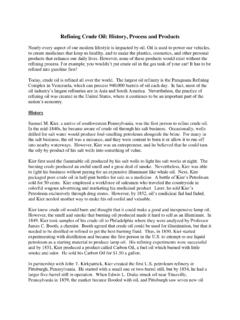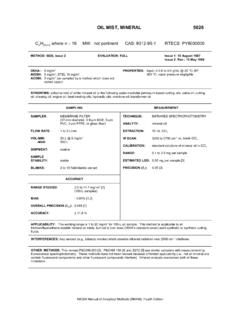Transcription of Early Oil Transportation: A Brief History
1 Early Oil transportation : A Brief History In the Early decades of the petroleum industry, the difficult work of oil production did not end once the well was drilled and the oil was removed from the ground. In fact, it could be argued that the next step in the production process was equally if not more difficult. The oil had to be moved, often hundreds of miles, from the well site to the refinery where it would be distilled into useful products. As the industry s pioneers, Pennsylvania s Early oil producers developed the first methods of transporting crude oil from the well site to the refinery. Some of their transportation methods have become obsolete over the last 150 years while others have evolved into the quick and efficient ways that we transport massive quantities of oil today. Teamsters and Horse-Drawn Wagons In 1859, the village of Titusville, Pennsylvania was the only town along the Oil Creek Valley.
2 The railroad had not yet reached Titusville; the town s only connection to the outside world was the stagecoach that visited from Erie, Pennsylvania twice a week. Farmland and dense woods with few proper roads dominated the rest of the rural valley. The area s lack of infrastructure made the prospect of transporting oil very daunting. The first method that Early oil producers used to transport their oil was the horse-drawn wagon. Teamsters were hired by drillers to haul oil from the drilling sites to rivers, railroads, or refineries. Teamsters dictated the price to haul wooden barrels of oil around the region, depending on road and weather conditions. Because of the impassable terrain and valuable service provided, teamsters charged up to $ to transport each barrel of oil. Even at this enormous price, there were around 6,000 wagons operating in the Early days of oil.
3 Teamsters came from neighboring farms and neighboring states to earn lofty amounts of money hauling barrels of oil. Since the wooden oil barrels used for storing oil were often leaky, teamsters and their wagons destroyed the roads in Pennsylvania s Oil Region with their heavy loads and the oil they spilled. In time, the dirt roads became consistently muddy and slick with oil. The dangerous conditions, rough terrain, and hard labor injured or killed many of the horses, mules, and oxen used to haul the wagons. Teamsters were the group of people most threatened by the coming of the railroad and the development of pipelines, some years later. They saw that these new methods of transporting oil had the potential to make their services unnecessary. Teamsters repeatedly attempted to sabotage newer and more efficient oil transportation methods by tearing up railroad tracks, cutting pipes, or burning the oil.
4 Nevertheless, progress soon triumphed and the teamsters had to find new employment. Flatboats and Barges Prior to 1862, the railroad did not service Pennsylvania s Oil Region. As a result, the region s waterways became the primary mode of transporting oil to market. Teamsters hauled oil from the well site to flatboats on Oil Creek. The flatboats were loaded with oil barrels and then floated down the very shallow creek to the Allegheny River via a pond freshet or artificial flood. A pond freshet was created by damming water on the principal branches of Oil Creek, some of which were as much as ten miles above Titusville, Pennsylvania. When a sufficient quantity of water had been held back, the dams were released on schedule, causing a significant rise in the creek s water level. A pond freshet was an event not to be missed.
5 Hundreds of flatboats each loaded with hundreds of barrels of oil would line up on Oil Creek. When the flood waters arrived, boatmen would cut loose their lines and be swept away on a wild and dangerous ride. The uncontrolled waters often caused the flatboats to crash into each other or bridge abutments, jamming the creek. A great deal of oil was lost to accidents. However, many experienced boatmen navigated the flood waters and delivered their oil without incident. Once at the Allegheny River, the oil was loaded onto barges that took it to refineries in Pittsburgh, Pennsylvania. In 1861, Jacob J. Vandergrift, a Pittsburgh riverboat captain and pilot on the Ohio River, brought his steamboat up the Allegheny River with a tow of two barges filled with 5,000 empty barrels. Upon arriving at the mouth of Oil Creek, he established what would become a very lucrative bulk shipping firm.
6 Vandergrift would buy oil when the price was low, store it, and then sell it during the late fall refining season in Pittsburgh and Philadelphia for a much higher price. Other rivermen joined Vandergrift in this profitable yet risky business, building boat landings and warehouses on the banks of the Allegheny River near the mouth of Oil Creek. During the Early years of the petroleum industry, these oil shippers were the principal market makers, bankers, and commodity traders for oil produced in the region. The majority of oil produced in Pennsylvania s Oil Region was transported via water until 1867 when sufficient railroad capacity was built to service the area. Railroad The first railroad to reach Pennsylvania s Oil Region arrived in November 1862. The Oil Creek Railroad stretched approximately 27 miles from Corry, PA to Titusville, PA.
7 It was a single track line, and for the first few years, the railroad was limited to transporting only 15% or approximately 30,000 barrels of the region s monthly 200,000 barrel oil production. Between 1862 and 1865, teamsters hauled barrels of oil from the well site to the railroad yards where the barrels were stacked on flatcars for transport. Unfortunately, the traditional wooden barrels were unreliable and leaky, and railway transportation only exacerbated the problem. A great deal of oil and therefore money was lost when the train s constant stops, starts, and swaying continuously sloshed the oil out of its confines. In 1865, Amos and James Densmore designed a more cost-effective way to transport oil by rail. The brothers invented and built the Densmore Tank Car, a specialty railroad car that could haul 80-90 barrels (nearly 3,400 gallons) of oil.
8 They used a flat train car and affixed two vertical 40-45 barrel tanks made of pine planks banded with iron. The first successful test of the Densmore Tank Car was in September, 1865. The car ran successfully on a line from Miller Farm (south of Titusville, Pennsylvania) to New York, with no oil loss. On April 10, 1866, the Densmore brothers were issued Patent No. 53,794 for the tank car. The success of the Densmore Tank Car revolutionized the transportation of oil by railway, leading competitors to copy the car s simple design and to improve upon it. Over the next several decades, many improvements were made, including metal construction, a single-tank design, and expansion domes that prevented leakage. By 1868, a boiler-type tank car was in use. These cylindrical horizontal tanks could carry 80 to 100 barrels of oil each.
9 The new tank cars were not top-heavy and were made of metal, so they did not leak oil. Today, these tank cars are still used to ship corn syrup and refined fuels. In 1867, a railroad loop comprised of rails laid by the Atlantic & Great Western Railroad, the Farmer s Railroad, and the Oil Creek Railroad was completed, encompassing the Oil Creek Valley. This improvement to the valley s railroad infrastructure in conjunction with the advent of the oil tank car allowed crude oil to be easily shipped by rail from the region to points east and west and elsewhere via connections, marking a significant shift in oil transportation from water to rail. Pipelines For years, Pennsylvania s Early oil men contemplated using pipelines to challenge the costly control teamsters had over the transport of crude oil. However, the dream was elusive until 1865, when Samuel Van Syckel created the first successful oil pipeline.
10 His pipeline stretched from Pennsylvania s Pithole boomtown to the Miller Farm on Oil Creek, near Titusville, Pennsylvania. The 2-inch wrought-iron pipe covered 5 miles and could carry approximately 2,000 barrels of oil every 24 hours with the help of three steam pumps. The most difficult problems for Van Syckel were the tumultuous teamsters and the terrain. Teamsters repeatedly tried to sabotage the pipeline (which was more efficient than their barrel-filled wagons) by cutting the pipes or burning the oil. Van Syckel safeguarded his pipeline by posting guards along its entire length. He conquered the difficult wilderness terrain by laying pipe both above and below ground. Van Syckel realized his idea of an oil pipeline and made oil transportation more cost effective for the oil producer. The oil industry s pipeline ventures continued to cover relatively short distances until the mid-1870s when Byron D.






